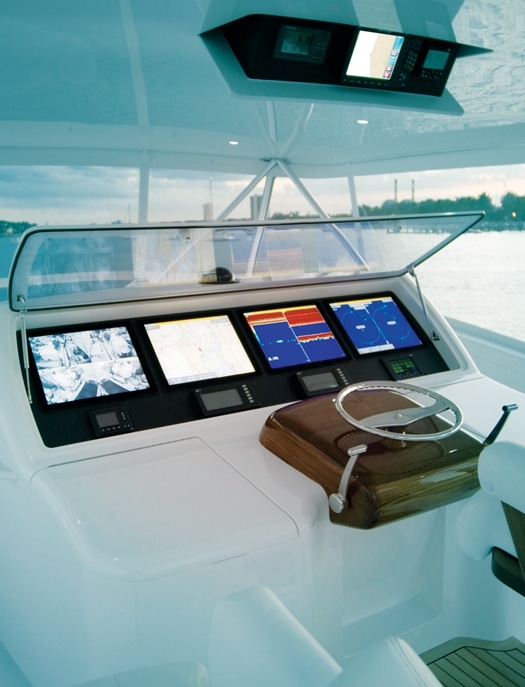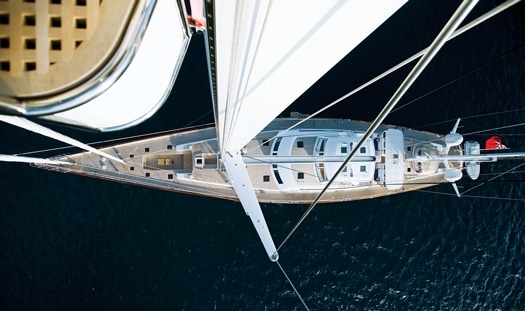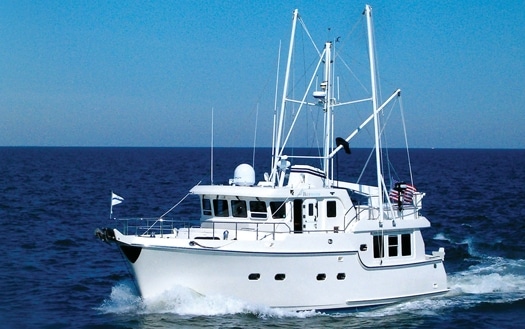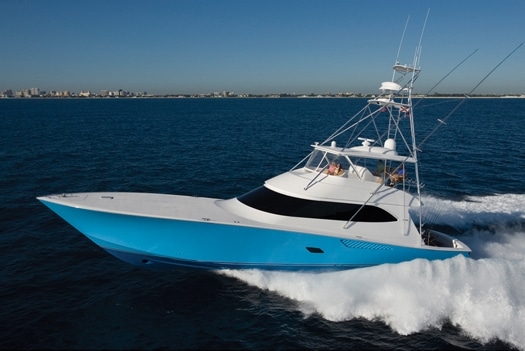
ytgmar29protect525.jpg
Even the simplest navigation, radar, and sounder arrays on today’s yachts are more powerful than those of the most sophisticated navy ship of the 1970s. Depending on the vintage of the system, the amount of data at a helmsman’s fingertips is staggering, with developments over the last few years pushing the power advantage to an exponential degree.
Protect Yourself and Your Boat
Every electronic device installed in the helm of a boat got there because it made the experience of those aboard more enjoyable and safer. As we get farther from the first generation of electronics and the interface gets smoother, the experience starts to feel more and more like a video game. But these devices serve a number of purposes-keeping the boat off the bottom, staying out of the crosshairs of big ships moving much faster than they appear to be, avoiding storms, being in touch to lend assistance to nearby vessels, keeping the helmsman relaxed, and watching engine data to head off problems before they become serious, to name a few.
Of course, some yachts have more technology than others. “There’s the man overboard function, where you push the man overboard button and it logs that position on the GPS and the FLIR camera’s able to go straight back to that position,” says Captain Andrew Barry of the 190-foot Royal Huisman sailing yacht Ethereal (see “Flirting with Perfection,” November 2009). “So if it’s at night for example, it actually goes into infrared so you can see someone at night.” Ethereal has multiple thermal-imaging cameras, positioned in high locations on the spreaders- even atop the mast, 185 feet up.

| | |
“If you get the call that someone’s in the water at a certain position, you’re able to render assistance,” says Barry. “We have screens in the pilothouse and we’re able to scroll and scan the ocean and look for someone from that height at the top of the mast. [A man in the water is] not so much hidden by the waves. We’re able to see into the troughs.”
Because helm electronics serve to simplify so many important tasks, they need to be protected themselves. “We set up our helm with an acrylic lid and we really don’t want customers to have to run with that lid open,” says Ryan Higgins, factory demo captain for Viking Yachts. “You just spend so much money on electronics, we try to have everything sealed, watertight, so the salt air isn’t going to affect the longevity.” The marine environment can degrade electronics, fogging screens and causing corrosion that blocks synapses in these high-tech brains. “We put the control pads in the radio boxes to either side of the helm, which have lids with gaskets,” says Higgins. “When you want to use the control pad, you just open the lid.”
The same goes for globetrotting Ethereal. “The equipment we have in the helm in the pilothouse is behind covered doors, all watertight doors, air-cooled and dehumidified air,” says Barry. “We have display units throughout the boat. . . so effectively we have helm stations that are all waterproof, without losing that accessibility to information and functionality that you need when you’re outside.”
Let Your Electronics Serve You
What sets experienced professional captains apart from many recreational captains? It would seem that the pros get more out of their electronics because they take full advantage of the huge amounts of useful information that the electronics pump out- they use all of their electronics all the time.
This is a big difference. On a beautiful, sunny afternoon cruise, who needs radar with its automatic radar plotting aid (ARPA), AIS, a sounder depicting up-to-the-minute depth data, a VHF set to watch three or more channels, engine monitoring fit for an ocean crossing, and a plotter with the latest 3-D cartography showing the contours of the channel and seabed for miles around? The answer may be a surprise, but you do.
If you’ve got it, use it. Many yachtsmen don’t use their electronics enough in good, easy conditions, where they can see how the devices actually work in a relatively pressure-free environment. Then, when visibility is poor and they need to power up that radar that they got just for such an occasion, they find that it isn’t as easy to set as they remembered. And more importantly, they don’t know how to read it as well as they thought. Or worse, they don’t trust what the instruments are telling them.
Your electronics are there to make your life easier. You’ve paid for them to be installed, and, hopefully, integrated properly. Make them work for you.
“The main thing with our setups now is that we’re pretty much setting everything up so we can control it right at our fingertips,” says Higgins. “You’re not leaning over the wheel to reach the helm panel or anything up forward. All of our control pads are in a radio box on a shelf right at your fingertips. And I think a lot of that has to do with the newer technology, all the black-box technology. We’re using monitors now that have separate remotes.”
Beyond the ergonomics, Higgins uses every square inch of monitor space, and he’s got four 17-inch KEP Marine screens, running a system based on Furuno’s NavNet 3D. “In the past when we didn’t have the dual-range radars we were kind of scrolling in tight to see what’s close, and scrolling out,” Higgins says. “You’re in and out nonstop with your face in the radar, seeing what’s ahead of you, what’s right in front of you. Now with the dual-range, I’ll keep one range at the quarter mile and the other range at two or three miles, just to see what’s in front of me.”
Because Higgins is fishing, he’s watching below the surface, too. “I keep one display on my sounder,” he says. “The way we have our transducer setup in the keel we can still mark bait at over 30 knots. That’s why I like that display just sticking out as big as possible, when we’re running and we get in that zone where I think we’re going to be fishing, I pay attention to where we’re marking bait.”
The rest of Higgins’s setup shows plenty of data. “The third display I use is my plotter, and then the other display I use for my engineroom cameras,” says Higgins.
While Higgins is chasing the fish, Barry is marshalling the clean resources of Ethereal, a yacht that has achieved carbonneutral status. “We have a monitoring system that tells us how much power we’re using on the boat at any time,” says Barry. “And it also has a trending graph, with which we can go back through the history of the boat to tell us what power is being used at any time, and that certainly helps us decide what is the most efficient power source.”
Helm-setup adjustments and efficiency tweaks aren’t just for the pros. After all, today’s integrated systems allow for split screens and customized displays. But what you do with the flow of information is more a function of mind-set than microchips. “When I moved from sail to power in the late 1980s, the choices were easy because I bought used boats and took what electronics came with the boats, a Grand Banks 32 followed by a Grand Banks 42,” says Milt Baker, founder of Bluewater

| | |
Books, who cruises with his wife Judy on their Nordhavn 47, Bluewater. “The electronics were still pretty simple: Loran, followed by GPS, autopilot, simple radar, depthsounder, VHF. We added single sideband, backup autopilot, a fishfinder, and replaced some of the old gear. Ergonomics on these boats was hitand- miss, and part of the problem was that gear was added and placed wherever there was room. Starting from scratch you’d never do it like that.”
What’s the Point?
The direction the bow is pointed makes all the difference, and so much of the helm’s electronic power is dedicated to showing and logging the yacht’s position relative to the rest of the world. And while you need to trust your equipment, you also need to have a backup plan, in case the electronics fail.
“The passages that we look forward to making on the boat- that planning is done on electronic charts,” says Barry. “But we still use paper charts. We won’t get away from that-we use them in conjunction with electronic charts. We have a legal obligation, due to shipping regulations to use paper charts, so we keep them onboard and keep them updated. The paper is something we’ve always done. In a way it’s part of the tradition, but it’s a great way to show people where we can go on the trip. At the end of the day, we still keep a log on paper.”
Technology has always impressed, but usually it’s the pro setups that impress the recreational cruisers, not the other way around. “My first autopilot was a very crude but effective Tiller Master, which could steer a much straighter course than I or any of my crew,” says Baker. “By the time I was ready to retire from the U.S. Navy in 1983, Judy and I owned an Allied Seawind II ketch and we outfitted it to sail to the Caribbean and beyond. Our pièce de résistance was a pricey Magnavox 4102 satellite navigator, which tracked Transit satellites and provided a ‘guaranteed’ position most anywhere in the world about every 90 minutes. It seems crude by today’s standards, but it was state-of-the-art in 1983. I still remember an early morning call from a 700-foot bulk ship as we approached St. Thomas, coming in from Martinique. The captain had us on radar but reported that he was a little confused about his position. I told him I could give him my position with certainty and he could compute his position from that. ‘How do you navigate?’ he asked. ‘By satellite navigation,’ I told him. ‘Well, sir, I will appreciate your position then because we are navigating celestially and it seems that your 32-foot sailboat is much more up-to-date than our 700-foot ship!'”
Shoot Straight
The bottom line: Your yacht can be filled to the gunwales with electronic equipment, but you’ve got to use those devices as the tools they are. While that constant flow of information from the screens needs to be seen and digested, you can’t operate with your gaze fixed on those pretty graphics. You need to look out the window for safety’s sake, but also because that view is a big part of why you’re out there.
The crew of Ethereal puts many eyes on watch, and uses their electronics to make them more effective. The yacht’s tenders have sounder systems that link to the helm navigation system and provide real-time depth data. “The boat has certainly been designed with exploration in mind, and getting to some farflung places around the earth and the navigation systems were designed with that in mind,” says Barry. “We have two crow’s nests, and cruising through the Caribbean we’ll put someone up the crow’s nest with a radio and have the tender out in front with the sounder, and so we’ll try to sneak into some of those anchorages may not be accessible without that technology.”

| | |
Technology that allows data flow within the yacht also helps to keep things running smoothly. Higgins pays close attention to what’s happening in his engineroom. “I’m a big believer in engineroom cameras: I’ve caught the start of small coolant leak that could have led to disaster,” he says. “Our enginerooms are all white, so when you see a coolant or fuel leak, you know obviously different coolants are different colors. A fuel leak-the bright-red-dyed diesel-will show up clear as day. Oil shows up clear as day. We usually put four cameras in the engineroom and I put it on the scroll mode.”
The huge screens on Higgins’s helm show plenty of detail, but a trip to the engineroom every now and again gives a real sense of how things are. “I also have TV pictures of the engineroom and steering gear in the lazarette,” says Baker. “But I still do my best to walk into the engineroom every hour or two and stop, look, listen, feel and smell. TV cameras are great but they cannot replace a visit to the engineroom.”
In spite of all the layers of protection we put in place, direct human contact with the environment at sea is why we’re all out there. Make the most of it. “I’m still very much in the look-out-the-window school of navigation, and I’d like to think I could get my little ship safely into port with little more than what I had on my first boat: a compass, a watch, and a knotmeter,” says Baker. “Still, with modern electronics it’s easy to have a great ‘big picture’ of what’s happening around you. That said, nothing quite compares with looking out the window!”









